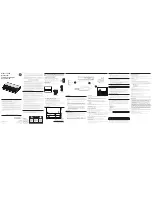
5
Technical Background on RS485
5.3 Polarization
In RS485 the sender must activate the transmitter before sending data, and deactivate it when all
data is sent. At times when no devices send data
all
transmitters are inactive. As the result the
data lines are floating, and the differential voltage is undefined. It may happen the next data is
not correctly recognized, because the change from undefined to data signals is not detected.
To avoid such problems the data lines should be polarized by resistors. These insure the differential
voltage to be above +200mV. Typically the positive line is pulled to +5V, while the negative line is
pulled to GND. When Termination Resistors are applied, the voltage on these must be +200mV or
above. When the termination resistors are of the 120Ω types, the polarization resistors shall have
about 750 to 1000Ω.
The Polarization Resistors must not be too small, because they add current to the signals, and a
transmitter has to act against that. A typical transmitter provides up to 60 mA of current in high
and low level.
5.4 2-Wire Scheme
In many configurations a very simple cabling is required. RS485 allows for so called 2-wire cabling
as shown below. Several devices are connected in parallel to the wires, which is called bus topology.
Each device can either send own or receive foreign data at a given time, so it is operating in
half-duplex mode.
Shown in figure
24
are three devices, RS485 specifies up to 32. The data lines are named as Data+
and Data-, a positive differential voltage is the state for a transmitted One. The GND is also
connected between all devices as required, so the cabling is 3-wire in reality.
Figure 24: 2-wire cabling scheme
The resistors P1 and P2 are for polarization, T1 and T2 are for the termination function. Polar-
ization of Data+ and Data- appears only once on this net, the termination is at the physical ends
of the cable.
All devices appear the same on the cable, they have the same function. There is no Master or
Slave defined by the hardware. Such functions are implemented by way of the data transmission
protocol. Also RS485 addresses are defined by that protocol, as well as bus access.
June 2009
USB-COM PRO User Manual
28




































